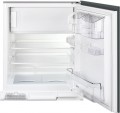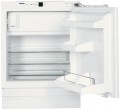Functions
Common features that apply directly to the entire appliance include
holiday mode,
control via smartphone,
child lock,
display,
door alarm,
auto door closer, and
reversible door. More about them:
— Holiday mode is an energy-saving feature intended for times when the refrigerator is not in use for an extended period, such as when there is no food inside. During this mode, the temperature inside the fridge compartment is kept around 12 degrees, which helps prevent the development of mold and unpleasant odors.
— Control via smartphone. This feature allows users to access and manage the unit from anywhere with an internet connection. This is achieved through Wi-Fi connectivity to a router or smart home system. The control can be done through a smartphone application or a web page available on any browser. This function provides users with information about the refrigerator's operating mode, including temperature, humidity, malfunctions, and emergency situations. The control via the internet is convenient and provides flexibility in controlling the refrigerator.
— Child lock. Many modern refrigerators come with safety features designed to prevent small children from tampering with the settings. These features usually involv
...e locking the control panel to prevent accidental adjustments. However, child locks for the doors are not typically included as a standard feature and must be purchased separately.
— Display. Displays can be found on refrigerators of various levels, from basic to advanced models. Regardless of the level, the display adds convenience to the operation of the unit by providing detailed information about its operation and displaying useful data, such as the time. In some cases, the display can also integrate with other smart home components. However, the cost of refrigerators with such features is typically higher.
— Door alarm. The refrigerator door alarm system alerts the user if the door has been left open for an extended period of time or not closed properly. This prevents spoilage of food due to a critical increase in temperature. The alarm usually gives a sound signal after a certain amount of time and some models also have a light indicator to confirm the correct closure of the door.
— Auto door closer. Auto-closing devices are installed on some refrigerators and are responsible for assisting in the closing and, in some cases, opening of the door. This helps to reduce the risk of leaving the door partially open or closed, while also ensuring a smooth, shock-free movement that can prolong the life of the refrigerator.
— Reversible door. Refrigerators with a classic design offer the ability to choose the location of the hinges, allowing users to decide on which side the door will open for optimal access. note that this function is only available for classic design models, including refrigerated display cases (see “Type”). This feature is not available in Side-by-Side and French Door models due to their design.Refrigerator capacity
The refrigerating compartment is designed for storage of products that do not require freezing, i.e. cooling down to temperatures below zero. The temperature range inside varies from +2 to +10. In almost all modern refrigerators, it is this compartment that has the largest volume.
To ensure optimal performance and food quality, it's important to choose the appropriate volume for the refrigerating compartment based on your actual food storage needs and how often you replenish your supplies. Overfilling the compartment can have a negative impact on both the refrigerator's performance and the quality of the stored food.
For singles or couples, a refrigerating compartment of up to 200 liters is enough, while families or those who stock up on food should opt for models with up to 400 liters. Vertical refrigerators with separate freezer access are suitable for those who need moderate storage space, while side-by-side refrigerators with their typically larger volumes are a good option for those who require even more space and have ample free space.
Fast cooling
Forced cooling mode is available in some refrigerators, and it significantly increases the cooling intensity of the refrigerator compartment. It's important to note that
fast cooling needs to be turned on and off properly to avoid overloading the compressor. Some models have an automatic shut-off feature, but it's important to check for this feature separately.
Freezer capacity
The primary function of the freezer is to store food in a state of deep freeze, which helps preserve perishable products such as meat, vegetables, fruits, etc. for extended periods of time. The necessary volume of the freezer depends on the planned amount of food to be stored and the length of time it will be stored. A larger freezer is particularly useful if you plan to store food for several months.
A compact freezer is relevant for short-term storage (for a day or two) or for seasonal devices (for example, in the village). It is best to ensure that the freezer is not overloaded and has enough space for proper circulation of air to maintain the desired temperature.
Freezer temperature
The lowest temperature provided by a refrigerator freezer.
The lower the freezer temperature indicator, the more advanced the freezer is considered to be, and the better it is suited for long-term food storage with wider capabilities. It's important to note that the standard operating temperature for a fully functional freezer is -18 °C, which is suitable for both storing and freezing pre-frozen foods. Some refrigerators are designed with a temperature indicator of -24 °C, but this is mainly achieved through the quick freezing mode (see "Functions"), and the standard operating temperature is still -18 °C. However, if you plan to freeze food frequently and store it for extended periods, it's better to choose a model with a temperature of -24 °C and consider the freezing power as well.
Less expensive refrigerators have a less advanced freezer with a modest minimum temperature of -12°C or even -6°C, which is only suitable for storing pre-frozen foods, not for freezing fresh food. Although they are much more affordable.
To indicate the temperature of the freezer, markings in the form of asterisks (snowflakes) are often used, each of which means a decrease in temperature by 6 °C. For example, the mentioned -18 °C will correspond to 3 asterisks (***).
Autonomy time
Refrigerators with good thermal insulation can maintain low temperatures inside for a significant amount of time even if there is a power outage. This period of time is known as the "keep cold time," during which the refrigerator can preserve perishable food items. A longer keep cold time indicates better thermal insulation, making the refrigerator more suitable for areas where power outages are common.
Freeze capacity
The freezing capacity of a refrigerator refers to the amount of fresh food it can freeze from room temperature to the freezer temperature within a 24-hour period. For everyday use, a freezing capacity of up to 10 kg/day is sufficient, but if you frequently freeze large volumes of food, you should consider a more
powerful freezer.
Controls
Refrigerator control panel. To date, there are such options:
—
Rotary switches. While a rotary switch technically has the potential to be used for a wide range of functions, in practice, this variety is typically only found in basic models with limited functionality. In such cases, control is often done manually by turning a thermostat knob, with limited options for adjusting temperature, humidity, and other settings.
—
Push-buttons. CRefrigerators can have a control panel with classic buttons that offer various functionalities depending on the model. These functionalities can range from basic adjustments (similar to rotary switches) to fine-tuning of temperature and humidity, control of special modes, and more. Compared to rotary switches, push-buttons generally offer a wider range of possibilities.
—
Touch. Touch panels are a modern and stylish control option for refrigerators, which requires a light touch to operate. They are considered the most advanced type of control, providing convenient and extensive functionality. Touch panels are typically installed in premium models, where they add to the device's aesthetic appeal with a minimum of unnecessary protruding parts.
Energy class
The energy class that the refrigerator corresponds to.
Energy consumption classes were originally designated with Latin letters from
A (the most efficient) to D (least efficient), but with technological advancements, more advanced classes such as "A+", "A++", etc. were introduced to indicate increasing levels of efficiency. The more pluses a device has, the more economical it is. This was necessary due to the correlation between energy consumption and decreasing efficiency.
For modern built-in refrigerators, the efficiency indicator at the level of class A can be called average,
A+ — not bad,
A++ — good,
A+++ — excellent. Energy consumption rates B and C are rare and mostly found in outdated or cheaper models. Achieving high efficiency requires design innovations, which results in higher device prices. However, these prices can be justified by the resulting reduction in electricity bills. It's worth noting that some built-in refrigerator models are available in different energy consumption classes, allowing customers to choose the best option for their budget and energy efficiency needs.

